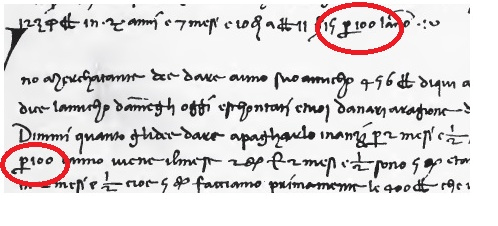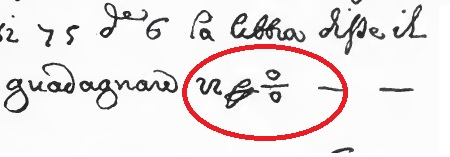Percent sign
| % | |||||
|---|---|---|---|---|---|
|
Percent sign | |||||
| |||||
The percent (per cent) sign (%) is the symbol used to indicate a percentage, a number or ratio as a fraction of 100. Related signs include the permille (per thousand) sign ‰ and the permyriad (per ten thousand) sign ‱ (also known as a basis point), which indicate that a number is divided by one thousand or ten thousand respectively. Higher proportions use parts-per notation.
Correct style
Spacing
English style guides prescribe writing the number and percent sign without any space between.[1][2][3][4][5][6][7] However, the International System of Units and ISO 31-0 standard prescribe a space between the number and percent sign,[8][9][10] in line with the general practice of using a non-breaking space between a numerical value and its corresponding unit of measurement.
Other languages have other rules for spacing in front of the percent sign:
- In Czech and in Slovak, the percent sign is spaced with a non-breaking space if the number is used as a noun,[11] whereas no space is inserted if the number is used as an adjective (e.g. “a 50% increase”).[12]
- In Finnish, the percent sign is always spaced, and a case suffix can be attached to it using the colon (e.g. 50 %:n kasvu 'an increase of 50%').[13]
- In French, the percent sign must be spaced with a non-breaking space.
- In Italian, the percent sign is never spaced.[14]
- In Spanish, the percent sign must always be spaced now, as almost every other symbol.
- In traditional Russian typography, the percent sign is never spaced. But it is not that common in Russia today.
- In Chinese, the percent sign is almost never spaced, probably because Chinese does not use spaces to separate characters or words at all.
- According to the Swedish Language Council, the percent sign should be preceded by a space in Swedish, as all other units.
- In German, the space is prescribed by the regulatory body in the national standard DIN 5008.
- In Turkish and other Turkic languages, the percent sign precedes rather than follows the number, without an intervening space.
- In Persian texts, the percent sign may either precede or follow the number, in either case without a space.
- In Arabic, the percent sign follows the number; as Arabic is written from right to left, this means that the percent sign is to the left of the number, usually without a space.
- In Hebrew, the percent sign precedes the number without intervening space; as Hebrew is written from right to left, this means that the percent sign is written to the right of the number, just as in English.
Usage in text
It is often recommended that the percent sign only be used in tables and other places with space restrictions. In running text, it should be spelled out as percent or per cent (often in newspapers). For example, not "Sales increased by 24% over 2006", but rather "Sales increased by 24 percent over 2006".[15][16][17]
Evolution
Prior to 1425 there is no known evidence of a special symbol being used for percentage. The Italian term per cento, "for a hundred", was used as well as several different abbreviations (e.g. "per 100", "p 100", "p cento", etc.). Examples of this can be seen in the 1339 arithmetic text (author unknown) depicted below.[18] The letter p with its descender crossed by a horizontal or diagonal strike conventionally stood for per, por, par, or pur in Mediaeval and Renaissance palaeography.[19]

At some point a scribe of some sort used the abbreviation "pc" with a tiny loop or circle (depicting the ending -o used in Italian numeration for primo, secondo, etc.) This appears in some additional pages of a 1425 text which were probably added around 1435.[20] This is shown below (source, Rara Arithmetica p. 440).

The "pc" with a loop eventually evolved into a horizontal fraction sign by 1650 (see below for an example in a 1684 text[21]) and thereafter lost the "per".[22]

In 1925 D.E. Smith wrote, "The solidus form (![]()
Usage
Encodings
Unicode
The Unicode code points are:
-
U+0025 % PERCENT SIGN (HTML
%) (%in HTML5[24]), -
U+2030 ‰ PER MILLE SIGN (HTML
‰·‰), -
U+2031 ‱ PER TEN THOUSAND SIGN (HTML
‱) a.k.a. basis point, and -
U+FF05 % FULLWIDTH PERCENT SIGN (HTML
%· see fullwidth forms) -
U+FE6A ﹪ SMALL PERCENT SIGN (HTML
﹪· see Small Form Variants)
There is also
U+066A ٪ ARABIC PERCENT SIGN (HTML ٪), which has the circles replaced by square dots set on edge, the shape of the digit 0 in Arabic numerals.
ASCII
The ASCII code for the percent character is 37, or 0x25 in hexadecimal.
In computers
Names for the percent sign include percent sign (in ITU-T), mod, grapes (in hacker jargon), and the humorous double-oh-seven (in INTERCAL).
In computing, the percent character is also used for the modulo operation in programming languages that derive their syntax from the C programming language, which in turn acquired this usage from the earlier B.[25]
In the textual representation of URIs, a % immediately followed by a 2-digit hexadecimal number denotes an octet specifying (part of) a character that might otherwise not be allowed in URIs (see percent-encoding).
In SQL, the percent sign is a wildcard character in "LIKE" expressions, for example SELECT * FROM table WHERE fullname LIKE 'Lisa %' will fetch all records whose names start with "Lisa ".
In TeX (and therefore also in LaTeX) and PostScript, and in GNU Octave and MATLAB,[26] a % denotes a line comment.
In BASIC, a trailing % after a variable name marks it as an integer.
In Perl % is the sigil for hashes.
In many programming languages' string formatting operations (performed by functions such as printf), the percent sign denotes parts of the template string that will be replaced with arguments. (See printf format string.) In Python and Ruby the percent sign is also used as the string formatting operator.[27][28][29]
In the command processors COMMAND.COM (DOS) and CMD.EXE (OS/2 and Windows), %1, %2,... stand for the first, second,... parameters of a batch file. %0 stands for the specification of the batch file itself as typed on the command line. The % sign is also used similarly in the FOR command. %VAR1% represents the value of an environment variable named VAR1. Thus:
set PATH=c:\;%PATH%
sets a new value for PATH, that being the old value preceded by "c:\;". Because these uses give the percent sign special meaning, the sequence %% (two percent signs) is used to represent a literal percent sign, so that:
set PATH=c:\;%%PATH%%
would set PATH to the literal value "c:\;%PATH%".
In the C Shell, % is part of the default command prompt.
In linguistics
In linguistics, the percent sign is prepended to an example string to show that it is judged well-formed by some speakers and ill-formed by others. This may be due to differences in dialect or even individual idiolects. This is similar to the asterisk to mark ill-formed strings, the question mark to mark strings where well-formedness is unclear, and the number sign to mark strings that are syntactically well-formed but semantically nonsensical.
See also
Notes
- ↑ Guardian and Observer style guide.
- ↑ "The Chicago Manual of Style". University of Chicago Press. 2003. Retrieved 2007-01-05.
- ↑ Publication Manual of the American Psychological Association. 1994. Washington, DC: American Psychological Association, p. 114.
- ↑ Merriam-Webster's Manual for Writers and Editors. 1998. Springfield, MA: Merriam-Webster, p. 128.
- ↑ Jenkins, Jana et al. 2011. The IBM Style Guide: Conventions for Writers and Editors. Boston, MA: Pearson Education, p. 162.
- ↑ Covey, Stephen R. FranklinCovey Style Guide: For Business and Technical Communication. Salt Lake City, UT: FranklinCovey, p. 287.
- ↑ Dodd, Janet S. 1997. The ACS Style Guide: A Manual for Authors and Editors. Washington, DC: American Chemical Society, p. 264.
- ↑ "SI Brochure". International Bureau of Weights and Measures. 2006. Retrieved 2016-05-05.
- ↑ "The International System of Units" (PDF). International Bureau of Weights and Measures. 2006. Retrieved 2007-08-06.
- ↑ "Quantities and units – Part 0: General principles". International Organization for Standardization. 1999-12-22. Retrieved 2007-01-05.
- ↑ "Internetová jazyková příručka". Ústav pro jazyk český Akademie věd ČR. 2014. Retrieved 2014-11-24.
- ↑ "Jazyková poradna ÚJČ AV ČR: FAQ". Ústav pro jazyk český Akademie věd ČR. 2002. Archived from the original on 2002-04-19. Retrieved 2009-03-16.
- ↑ "Kielikello 2/2006". kotus.fi. Kotimaisten kielten keskus. 2006. Retrieved 2015-06-30.
- ↑ "Dire Fare Scrivere - Mensile di cultura e scrittura" (in Italian). Botteg Editoriale. November 2006. Retrieved 9 January 2015.
- ↑ American Economic Review: Style Guide Archived 2007-12-25 at the Wayback Machine.
- ↑ UNC Pharmacy style guide
- ↑ University of Colorado style guide
- ↑ Smith 1898, p. 437
- ↑ Letter p. / Cappelli, Adriano: Lexicon Abbreviaturarum. 2. verb. Aufl. Leipzig 1928. Wörterbuch der Abkürzungen: P. pages 256–257
- ↑ Smith 1898, pp. 439-440
- ↑ Smith 1898, p. 441
- ↑ Smith 1898, p. 440
- ↑ Smith 1925, Vol. 2, p. 250 in Dover reprint of 1958, ISBN 0-486-20430-8
- ↑ HTML5 is the only version of HTML that has a named entity for the percent sign, see https://www.w3.org/TR/html4/sgml/entities.html ("The following sections present the complete lists of character entity references.") and https://www.w3.org/TR/2014/CR-html5-20140731/syntax.html#named-character-references ("percnt;").
- ↑ Thompson, Ken (1996). "Users' Reference to B". Archived from the original on 2006-07-06.
- ↑ "2.7.1 Single Line Comments". GNU.
- ↑ "Python 2 – String Formatting Operations".
- ↑ "Python 3 – printf-style String Formatting".
- ↑ "Ruby – String#%".
References
- Smith, D. E. (1898), Rara Arithmetica: a catalogue of the arithmetics written before MDCI, with description of those in the library of George Arthur Plimpton of New York, Boston: Ginn
- Smith, D. E. (1925), History of Mathematics, Boston: Ginn